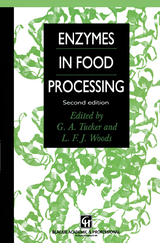Enzymes in Food Processing
Chapman and Hall (Verlag)
978-0-7514-0249-0 (ISBN)
Recent years have seen a rapid increase in the use of enzymes as food processing tools, as an understanding of their means of control has improved. Since publication of the first edition of this book many new products have been commercially produced and the corresponding number of published papers has swollen. This second edition has been fully revised and updated to cover changes in the last five years. It continues to provide food technologists, chemists, biochemists and microbiologists with an authoritative, practical and detailed review of the subject.
1 Fundamentals of enzyme activity.- 1.1 Introduction.- 1.2 What is an enzyme?.- 1.3 Enzyme nomenclature.- 1.4 Enzyme purification and assay.- 1.5 Enzyme kinetics.- 1.6 Enzyme immobilisation.- 1.7 Genetic engineering.- References.- 2 Enzymes in the food industry.- 2.1 Introduction.- 2.2 Commercialisation of enzyme processes.- 2.3 Alternative methods to the use of enzymes.- 2.4 Accessibility of substrate to enzyme.- 2.5 Types of reaction.- 2.6 Reaction conditions.- 2.7 Source of enzymes.- 2.8 Legal and safety implications.- 2.9 Use of enzymes.- References.- 3 Food enzymes and the new technology.- 3.1 Overview of the new technologies.- 3.2 Understanding how protein structure controls function.- 3.3 Relating structure to function.- 3.4 A rational approach to reactions in organic solvents.- 3.5 Can abzymes become as efficient and economical as enzymes?.- Acknowledgements.- References.- 4 Enzymes in milk and cheese production.- 4.1 Introduction.- 4.2 Enzymes in relation to milk production.-4.3 Enzymes in relation to cheese manufacture.- 4.4 Concluding remarks.- Acknowledgements.- References.- 5 Enzymes in the meat industry.- 5.1 Introduction.- 5.2 Development of rigor.- 5.3 Loss of rigor stiffness.- 5.4 Ultrastructural modifications in the myofibril.- 5.5 Connective-tissue weakening.- 5.6 Muscle proteinase.- 5.7 Interaction of muscle proteinases in conditioning.- 5.8 Effect of age and growth rate on muscle proteinases and meat quality.- 5.9 Tenderising enzymes.- 5.10 Enzymic recovery processes.- 5.11 Conclusions.- References.- 6 Enzymes in the baking industry.- 6.1 Introduction.- 6.2 The need for problem solvers.- 6.3 Sources of technical enzymes.- 6.4 Regulations.- 6.5 The use of enzymes in the baking industry.- 6.6 Starch-degrading enzymes.- 6.7 Proteinases.- 6.8 Pentosanases.- 6.9 Lipases.- 6.10 Oxidoreductases.- 6.11 General considerations.- References.- 7 Enzymes in the production of beverages and fruit juices.- 7.1 Introduction.- 7.2 Tea.- 7.3 Cocoa.- 7.4 Beer andwhisky.- 7.5 Wine.- 7.6 Cider.- 7.7 Apple juice.- 7.8 Endogenous fruit enzymes.- 7.9 Other non-citrus fruits.- 7.10 Citrus juice processing.- 7.11 Citrus de-bittering.- 7.12 Other enzymic applications.- 7.13 Conclusion.- References.- 8 Enzymes in the starch and sugar industries.- 8.1 Introduction.- 8.2 Applications of hydrolytic enzymes in starch and sugar conversions.- 8.3 Applications of non-hydrolytic enzymes in starch and sugar conversions.- 8.4 Production of fine chemicals by enzymic conversions of starch and sugars.- 8.5 Conclusion.- References.- 9 Enzymes in the processing of fats and oils.- 9.1 Introduction.- 9.2 Structure and function of lipases.- 9.3 Specificity of lipases.- 9.4 Stability of lipases.- 9.5 Lipases in the interface.- 9.6 Non-interfacial uses of lipases.- 9.7 Applications.- 9.8 The dairy industry.- 9.9 Lipases as process aids.- 9.10 Hydrolysis of triglycerides.- 9.11 Interesterification and randomisation.- 9.12 Manipulation of fats other than by lipases.- 9.13 Lipoxygenases.- 9.14 Glycolipids.- 9.15 Phospholipids.- 9.16 Manipulation of raw materials.- 9.17 Conclusions.- References.- 10 Enzymes as diagnostic tools.- 10.1 Introduction.- 10.2 Enzyme kinetics in relation to diagnosis.- 10.3 Unlabelled enzymes in diagnosis.- 10.4 Enzymes as analytical aids.- 10.5 Enzyme conjugates used in diagnosis.- 10.6 Applications of enzyme conjugates in microbiology.- 10.7 Non-microbiological applications of enzyme conjugates.- 10.8 Future trends and perspectives.- References.
| Zusatzinfo | XII, 319 p. |
|---|---|
| Verlagsort | London |
| Sprache | englisch |
| Maße | 155 x 235 mm |
| Themenwelt | Naturwissenschaften ► Biologie ► Biochemie |
| Technik ► Lebensmitteltechnologie | |
| ISBN-10 | 0-7514-0249-4 / 0751402494 |
| ISBN-13 | 978-0-7514-0249-0 / 9780751402490 |
| Zustand | Neuware |
| Haben Sie eine Frage zum Produkt? |
aus dem Bereich




